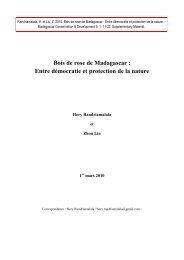Journal Madagascar Conservation - Madagascar Wildlife ...
Journal Madagascar Conservation - Madagascar Wildlife ...
Journal Madagascar Conservation - Madagascar Wildlife ...
Create successful ePaper yourself
Turn your PDF publications into a flip-book with our unique Google optimized e-Paper software.
MADAGASCAR CONSERVATION & DEVELOPMENT VOLUME 3 | ISSUE 1 — DECEMBER 2008 PAGE 22<br />
Bats as bushmeat in <strong>Madagascar</strong><br />
Richard K. B. Jenkins I,II and Paul A. Racey II<br />
ABSTRACT<br />
Bats are eaten by people throughout <strong>Madagascar</strong> and although<br />
the larger species like Pteropus rufus, Eidolon dupreanum,<br />
Rousettus madagascariensis and Hipposideros commersoni are<br />
preferred, small insectivorous bats are also eaten. The national<br />
hunting season for bats is widely ignored and both unsuitable<br />
hunting practices and high offtake represent a serious threat<br />
to bat populations in some areas. Bat bushmeat may be an<br />
important source of protein for Malagasy people during periods<br />
of food shortage but in general there are few data on the socio-<br />
economic and cultural importance of bats. Fruit bats produce<br />
a single offspring per year and are therefore susceptible to<br />
over - hunting. Nevertheless, large roosts offer the possibility of<br />
community managed harvests to secure the colony and provide<br />
a source of meat but further research is needed before this can<br />
be considered. Roost sites also present the best focus for conservation<br />
and greater effort is needed to control hunting using<br />
existing legislation and flexible community - based solutions that<br />
are sensitive to the local context. The threat of pathogen transfer<br />
from bats to people is of growing concern as more bat species<br />
are identified as vectors of emergent viral diseases.<br />
RÉSUMÉ<br />
Les gens consomment des chauves-souris partout à <strong>Madagascar</strong><br />
et s’ils préfèrent les plus grandes espèces comme Pteropus<br />
rufus, Eidolon dupreanum, Rousettus madagascariensis et<br />
Hipposideros commersoni, les petites chauves - souris insectivores<br />
sont également consommées. La période d’ouverture<br />
nationale de la chasse n’est généralement pas respectée et<br />
l’on assiste aussi bien à de mauvaises pratiques cynégétiques<br />
qu’à des prélèvements importants qui représentent une<br />
menace sérieuse pour les populations de chauves - souris<br />
dans certaines régions. Les chauves-souris peuvent constituer<br />
une source de protéines importante pour les populations villageoises<br />
pendant les périodes de soudure alimentaire mais<br />
en règle générale, il existe peu de données sur les valeurs<br />
socio - économiques ou culturelles des chauves - souris. Les<br />
chauves - souris frugivores ne produisent qu’un seul jeune par<br />
an, de sorte qu’elles sont sensibles à la pression de chasse<br />
bien que les grands dortoirs pourraient offrir l’occasion d’une<br />
I Madagasikara Voakajy, B. P. 5181, Antananarivo (101), <strong>Madagascar</strong><br />
II School of Biological Sciences, University of Aberdeen, Aberdeen, AB24 2TZ, UK<br />
Correspondence:<br />
Richard K. B. Jenkins<br />
Madagasikara Voakajy, B. P. 5181<br />
Antananarivo (101), <strong>Madagascar</strong><br />
E-mail: jenkins@moov.mg, r.jenkins@abdn.ac.uk<br />
exploitation gérée par la communauté pour assurer la sécurité<br />
des colonies et fournir une source de protéines mais<br />
de plus amples recherches sont nécessaires avant que cette<br />
alternative ne puisse être retenue. Les dortoirs constituent<br />
également les meilleures cibles des actions de protection de<br />
la nature et des efforts plus importants sont nécessaires pour<br />
contrôler la chasse en s’appuyant sur la législation nationale<br />
ainsi que sur des solutions locales plus souples et adaptées,<br />
basées sur la communauté. Les chauves - souris peuvent<br />
aussi transmettre des agents pathogènes et cette menace<br />
est une source d’inquiétude grandissante car de plus en plus<br />
d’espèces de chauves-souris ont été identifiées en tant que<br />
vecteurs de maladies virales émergentes.<br />
KEYWORDS: bats, bushmeat, Eidolon, Hipposideros, hunting,<br />
Pteropus, Rousettus, roost<br />
INTRODUCTION<br />
Hunting of wildlife for food is a major threat to forest vertebrates<br />
in the tropics (Wilkie et al. 1998. Bakarr et al. 2001, Fa<br />
et al. 2002, Corlett 2007), but wild meat provides people with<br />
a vital source of protein and income (de Merode et al. 2004).<br />
Understanding the dynamics of bushmeat hunting, consumption<br />
and trade, especially the supply and demand of species that are<br />
of conservation concern, is a priority in areas where exploitation<br />
levels are high. For the more productive and abundant species,<br />
sustainable extraction may be possible, thus enabling local communities<br />
to use this resource for food and income (Robinson<br />
and Bennett 2004).<br />
Most bushmeat studies in Africa have concentrated on<br />
central and western tropical forests on the mainland (e.g. Bakarr<br />
et al. 2001, Fa et al. 2005, Willcox and Namu 2007). By contrast,<br />
there are only a few accounts from the island of <strong>Madagascar</strong>, but<br />
there is evidence of an established hunting culture that points<br />
to regular consumption of terrestrial and flying vertebrates for<br />
food (Linton 1933). Wild animals that are hunted and consumed<br />
by people in <strong>Madagascar</strong> include lemurs, tenrecs, carnivores,<br />
bats, birds and reptiles (Randriamanalina et al. 2000, Garcia and<br />
Goodman 2003, Goodman and Raselimanana 2003, Goodman et<br />
al. 2004, Rakotondravony 2006).



